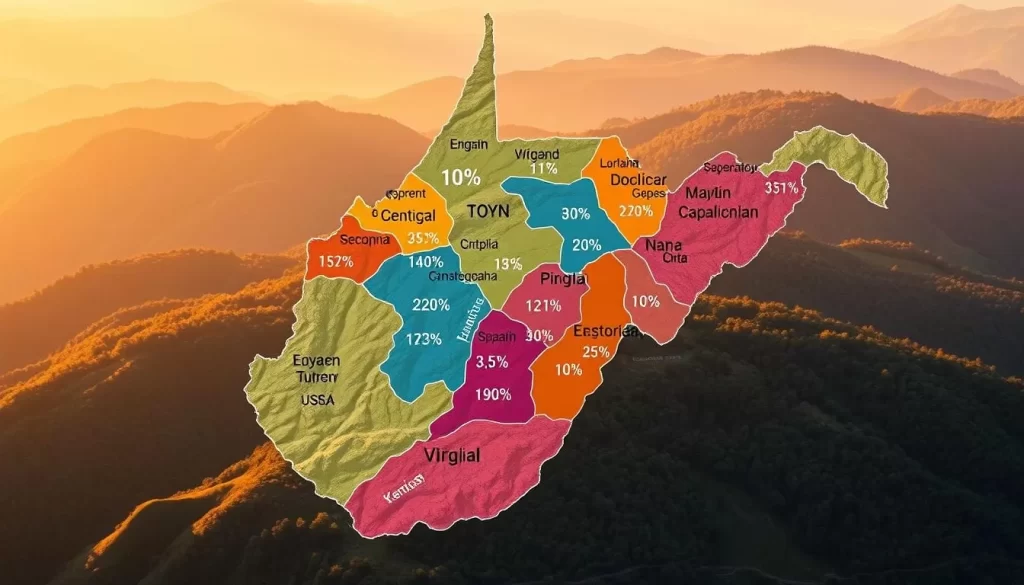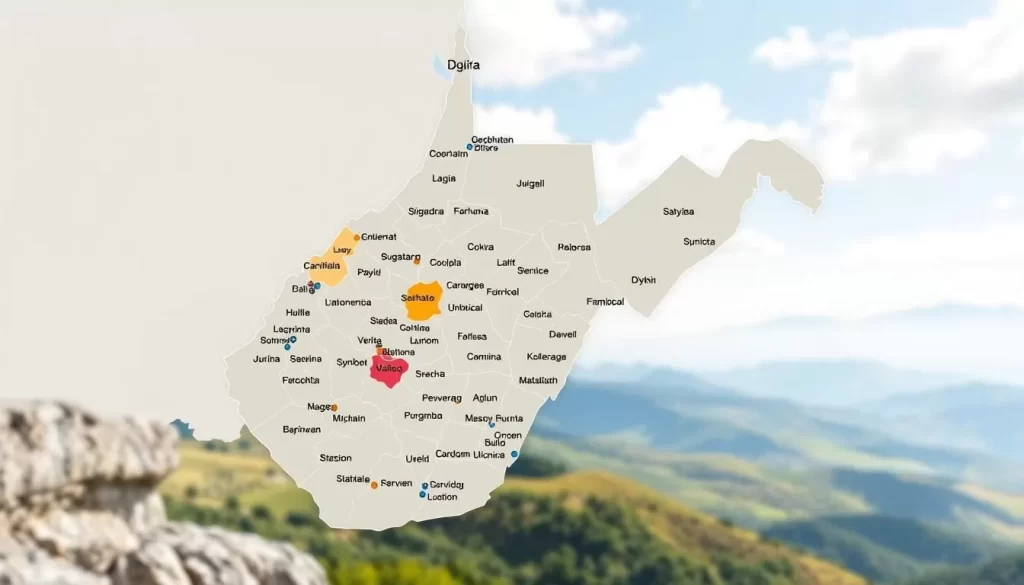You’re about to explore the diverse linguistic landscape of West Virginia, a state with a unique cultural identity shaped by its history and geography.
According to census data, the percentage of people speaking languages other than English at home in West Virginia is significantly lower than the national average in the United States.
This difference highlights the importance of understanding the language demographics in West Virginia, including the population‘s linguistic diversity and the percentage of households speaking multiple languages.
As we delve into the details, you’ll gain insights into the historical factors that have influenced language use in the state and how these patterns continue to evolve.
The Linguistic Landscape of West Virginia
Understanding West Virginia’s linguistic landscape requires examining its demographic composition and historical development. You will discover that the state’s language profile is distinct from other parts of the United States.
Overview of Language Demographics
West Virginia is characterized by a linguistically homogeneous population, with English being the dominant language throughout the state. The data shows that the percentage of non-English speakers is significantly lower compared to national averages. For instance, Spanish is the most common non-English language, spoken by approximately 1.04% of the population, or about 18,164 people.
Language Demographics Data:
| Language | Speakers | Percentage of Total Population |
|---|---|---|
| English | 1,733,836 | 98.5% |
| Spanish | 18,164 | 1.04% |
| Other Languages | 8,000 | 0.46% |
Historical Context of Languages in West Virginia
The historical development of West Virginia’s language patterns has been influenced by specific immigration waves, industrial development, and geographical isolation. The coal mining industry, railroad development, and manufacturing sectors attracted particular immigrant groups, shaping the language distribution patterns that persist today. As a result, Appalachian English varieties have developed unique characteristics, creating distinctive dialects across different regions of the state.

You’ll learn how the state’s demographic composition has contributed to its current linguistic landscape. The historical context and data on language demographics provide a comprehensive understanding of West Virginia’s linguistic identity.
English as the Predominant Language
As you explore the linguistic landscape of West Virginia, it becomes clear that English plays a dominant role. The state’s language demographics reveal a predominantly English-speaking population, with over 97% of residents speaking primarily English at home. This characteristic places West Virginia among the states with the highest percentage of English-only speakers in the United States.

English-Only Speakers in West Virginia
The data indicates that West Virginia has one of the highest percentages of English-only speakers. This linguistic homogeneity can be attributed to various factors, including historical settlement patterns, geographic isolation, and limited international migration. As a result, the majority of the population in West Virginia uses English as their primary language for daily communication.
- The high percentage of English-only speakers reflects the state’s cultural and demographic characteristics.
- West Virginia’s linguistic profile is shaped by its history and geographic location.
English Proficiency Rates Compared to National Average
While English is predominant, the data shows that English proficiency rates among non-English speakers vary significantly by language group. For instance, among Spanish speakers in West Virginia, approximately 47.8% speak English ‘very well,’ while 52.2% have limited English proficiency. This variation highlights the need for targeted language support services in areas such as education, healthcare, and government services.
- English proficiency rates among non-English speakers in West Virginia show interesting patterns compared to national averages.
- The state’s English proficiency rates impact various sectors, including education and healthcare.
Top Non-English Languages Spoken in West Virginia
As you explore the linguistic landscape of West Virginia, you’ll discover a diverse array of languages spoken across the state. The data reveals that while English is the predominant language, there are significant numbers of people speaking other languages at home.
Spanish: The Most Common Non-English Language
Spanish stands out as the most widely spoken non-English language in West Virginia, with 6,677 speakers who have limited English proficiency. This reflects the growing Hispanic population in the state, which has contributed to the cultural and linguistic diversity.
The presence of Spanish speakers is notable in various parts of West Virginia, with many households using Spanish as their primary language.
Chinese Languages
Chinese languages, including Mandarin and Cantonese, are the second most common non-English languages spoken in West Virginia, with 1,534 speakers. These languages are often found in university towns and urban centers, where there are larger concentrations of international students and professionals.
German and French Speakers
German and French speakers also have a presence in West Virginia, reflecting the state’s historical immigration patterns. There are 668 German speakers and 711 French speakers, indicating a continued interest in these languages.
Arabic and Other Notable Languages
Arabic is another notable language, with 654 speakers in West Virginia. Other languages, such as Vietnamese (592 speakers), Korean (369 speakers), Japanese (346 speakers), and Tagalog (336 speakers), contribute to the state’s linguistic diversity.

| Language | Number of Speakers |
|---|---|
| Spanish | 6,677 |
| Chinese | 1,534 |
| French | 711 |
| German | 668 |
| Arabic | 654 |
West Virginia, United States: Official and Widely Spoken Languages Data Analysis
As you explore the linguistic landscape of West Virginia, you’ll discover intriguing patterns in language distribution across the state. The data provides a comprehensive view of the languages spoken at home, shedding light on the state’s cultural diversity.
Language Distribution by Percentage
The language data for West Virginia reveals that a small percentage of the population speaks languages other than English at home. For instance, approximately 1.04% of the population speaks Spanish, which is significantly lower than the national average of 13.11%. Other languages spoken in the state include Chinese (0.17%), German (0.16%), French (0.14%), and Arabic (0.11%).
- The percentage of Spanish speakers in West Virginia is notably lower than the national average.
- Chinese, German, French, and Arabic speakers constitute a small fraction of the state’s population.
- The data highlights the predominantly English-speaking nature of West Virginia.

Population Demographics and Language Correlation
Analyzing the correlation between language distribution and population demographics in West Virginia reveals interesting trends. You can gain insights into how demographic factors such as age, education level, and economic status influence language use. For example, certain languages may be more prevalent among specific age groups or in particular regions.
- The data analysis shows that language use varies across different demographic segments.
- Understanding these patterns can help identify areas with linguistic diversity.
- The correlation between language distribution and demographic factors provides a multidimensional view of West Virginia’s population characteristics.
By examining the relationship between language distribution and demographic indicators, you can develop a deeper understanding of West Virginia’s community dynamics and cultural identity.
English Proficiency Among Non-Native Speakers
As the population of West Virginia continues to evolve, examining English proficiency rates among non-native speakers provides valuable insights into the state’s cultural landscape. You can gain a deeper understanding of the challenges and opportunities that come with linguistic diversity in the state.
Speaking English “Very Well” Statistics
The data on English proficiency among non-native speakers in West Virginia reveals interesting trends. For instance, among Spanish speakers, 47.8% speak English “very well,” while among Chinese speakers, the percentage is 44.5%. German speakers, on the other hand, have a higher English proficiency rate, with 76.9% speaking English “very well.”
| Language Group | % Speaking English “Very Well” | Limited English Proficiency (LEP) % |
|---|---|---|
| Spanish | 47.8% | 52.2% |
| Chinese | 44.5% | 55.5% |
| German | 76.9% | 23.1% |
Limited English Proficiency (LEP) Population
The Limited English Proficiency (LEP) population in West Virginia faces unique challenges, particularly in accessing essential services and economic opportunities. You can see that the LEP population varies significantly across different language groups, with 52.2% of Spanish speakers and 55.5% of Chinese speakers having limited English proficiency.
Understanding these dynamics is crucial for policymakers and service providers to allocate resources effectively and ensure that all residents of West Virginia have equal access to opportunities.
Geographic Distribution of Languages in West Virginia
As you explore the linguistic landscape of West Virginia, you’ll notice distinct patterns in language distribution across different regions. The state’s diverse geography, including the Appalachian Mountains, has played a significant role in shaping the linguistic diversity across its urban and rural areas.
Urban vs. Rural Language Patterns
You’ll see how language distribution varies significantly between West Virginia’s urban centers and rural communities. Non-English languages are concentrated primarily in metropolitan areas, where universities and medical centers are located. For instance, university towns like Morgantown and Huntington show greater linguistic diversity compared to more rural counties. This diversity is largely due to the presence of educational institutions and healthcare facilities that attract people from various linguistic backgrounds.
Language Communities Across State Districts
The data reveals interesting patterns across West Virginia’s state districts (WV-1 through WV-67), with certain regions showing higher concentrations of specific language communities. Historical settlement patterns, economic development, and institutional presence have shaped language distribution throughout the state. You can observe how different districts have unique linguistic profiles, influenced by factors such as the presence of universities, industrial centers, and demographic characteristics of the population.
Language Trends and Evolution in West Virginia
Understanding West Virginia’s language evolution provides valuable insights into its cultural identity. As you delve into the state’s linguistic landscape, you’ll discover how historical events, demographic shifts, and economic changes have shaped the way people communicate.
Historical Changes in Language Demographics
Historically, West Virginia has maintained a predominantly English-speaking population, with less linguistic diversification compared to other states. However, recent trends indicate a slight increase in Spanish and Chinese speakers, particularly around educational institutions and healthcare facilities. This shift reflects broader economic and social changes throughout the state’s history, from early European settlement through industrialization to the present day.
The data reveals gradual shifts in language demographics, influenced by factors such as migration patterns and economic development. You can gain a deeper understanding of these changes by examining the historical context of languages in West Virginia.
Projected Future Language Trends
Looking ahead, projections suggest that West Virginia’s language trends will continue to evolve based on current demographic patterns, migration forecasts, and economic development plans. Factors such as educational institutions, healthcare facilities, and changing industries are likely to influence language distribution in the coming decades. By analyzing these trends, you’ll be able to anticipate how West Virginia’s linguistic landscape may change in the future.
The state’s language evolution is also comparable to similar rural and Appalachian states, providing a regional context for understanding linguistic patterns. As you explore these trends, you’ll gain a better understanding of the complex dynamics shaping West Virginia’s language demographics.
Economic and Social Impact of Language Diversity
The linguistic landscape of West Virginia, though relatively homogeneous, has notable effects on key sectors of the state’s economy and society. As you explore the economic and social implications of language diversity, you’ll gain insights into how different industries and services are impacted.
Business and Industry Considerations
West Virginia’s relatively homogeneous linguistic landscape affects business operations, particularly for companies considering expansion into the state. Correlations between language communities and specific industries reveal economic patterns tied to linguistic demographics. For instance, certain industries may be more prevalent in areas with higher concentrations of specific language speakers.
- Industries such as healthcare and education are adapting to the needs of diverse language populations.
- Businesses may need to consider language assistance services to cater to a broader customer base.
Educational and Healthcare Implications
Educational institutions in West Virginia, especially those with international student populations, have developed multilingual resources to address language diversity. Healthcare facilities, particularly in urban areas, increasingly provide language assistance services to ensure accessibility for limited English proficiency populations.
By understanding the economic and social impact of language diversity, you can better appreciate the complexities of West Virginia’s communities and the adaptations being made across various sectors.
Conclusion: Understanding West Virginia’s Linguistic Identity
As we conclude our exploration of West Virginia’s language landscape, it’s clear that the state’s linguistic homogeneity is a defining characteristic. With over 97% of the population speaking English at home, West Virginia maintains one of the most linguistically homogeneous populations in the United States.
You’ll gain a comprehensive understanding of West Virginia’s unique linguistic identity and how it shapes the state’s cultural landscape. The data presented throughout this report provides valuable insights for policymakers, educators, healthcare providers, and businesses operating in West Virginia. Understanding the state’s language patterns is crucial for effective service delivery, policy development, and community engagement.
The linguistic landscape of West Virginia reflects broader aspects of the state’s history, geography, economy, and demographic composition. As the state continues to evolve, understanding its linguistic identity will remain important for addressing the needs of its population and fostering community cohesion. By examining the intersection of language considerations with other important factors in West Virginia’s development, you can develop more effective strategies for education, healthcare, economic growth, and community development.
The above is subject to change.
Check back often to TRAVEL.COM for the latest travel tips and deals.





